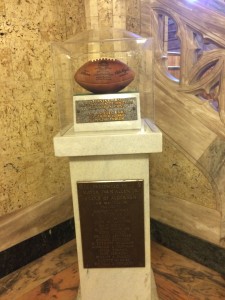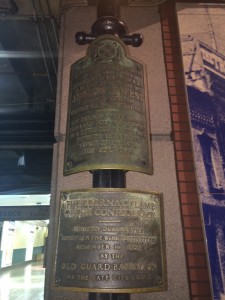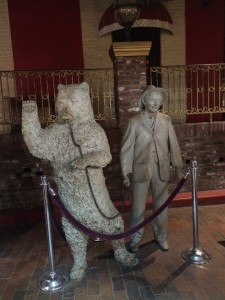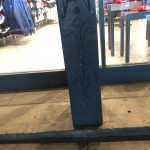Thi s Atlanta Gazette newspaper box sits outside the City Hall on Mitchell Street. Although there’s no date on it, the box appears to be fairly old and is a relic of a past Atlanta. It appears to have been vandalized and cleaned off, which indicates to me that it is of some relative value, but it wouldn’t open and there was no clues as to why is remains there.
s Atlanta Gazette newspaper box sits outside the City Hall on Mitchell Street. Although there’s no date on it, the box appears to be fairly old and is a relic of a past Atlanta. It appears to have been vandalized and cleaned off, which indicates to me that it is of some relative value, but it wouldn’t open and there was no clues as to why is remains there.
Built Environment Descriptions
Atlanta’s First Major League Baseball
Atlanta’s first major league baseball is one of only a few items on display in the City Hall atrium. The baseball commemorates the Braves’s first game in Atlanta after moving from Milwaukee. This artifact is clearly very important to the city, and it sits on a pedestal by one of the doors.
Fun fact: in a shocking turn of events, the Braves lost the game.
First National League Football
One of the few objects on display in the City Hall atrium is the first football. This object looks used. Dirty hand prints are visible on the surface, which makes it seem more authentic. It was presented to Mayor Ivan Allen, Jr. in 1966, the same year the Braves came to Atlanta and sits opposite the baseball that commemorates their first game.
Fun fact: In another shocking turn of events, the Falcons lost the game.
Memorial Plaque
This metal plaque was one of the first things I saw upon entering City Hall. Even before stepping in the atrium this tablet greets guests in the entryway. It depicts a soldier holding a tablet shield emblazoned with the words “patriotism” and “devotion” and, like most of the artifacts in the City Hall, commemorates a specific event. In this case, the explosion of the U.S. Maine.
Historic Gas Lamp
This gas lamp is located at the entrance to the Five Points MARTA station and features an eternal flame that was lit during the festivities surrounding the premiere of the movie Gone With the Wind.
The first plaque reads, “The damage at the base of this lamp post was caused by a shell during the War Between the States, Battle of Atlanta. July 22nd, 1864.”
Dancing Bear Statue at Humbug Square
Dante’s Down the Hatch
Believe it or not, this is entrance to Dante’s Down the Hatch, a pirate-themed restaurant that closed down for good three years ago. The center piece of Underground Atlanta, this is perhaps the only business that survived the the Underground revival of the 1980s, when a significant portion of the site was demolished in order to construct MARTA lines. Visitors would open the “hatch” to reveal the a staircase that led down into the popular restaurant. If you peer through the crack, the staircase is still visible.
Kenny’s Alley
True to its name, the majority of Underground Atlanta is just that–underground. Kenny’s Alley, however, is an outdoor area that once boasted many storefronts, restaurants, and clubs. Practically deserted like the rest of the facility, I stumbled upon this area after riding an escalator to street level.
Pryor Street Sign
(Abandoned) City Beneath the Streets
Underground Atlanta, home to the city’s annual Peach Drop celebration, is nearly deserted on a Saturday evening, and there’s no peach in sight.  On this particular occasion, a piano sits under the entrance arch, which advertises shops, restaurants, and entertainment, and a man sits at it, playing a pleasant tune. The site has suffered from a decrease in business over the past few years, and while its stone buildings and cobblestone streets still hold a certain charm, the ambiance is disrupted by a sense of abandonment.
On this particular occasion, a piano sits under the entrance arch, which advertises shops, restaurants, and entertainment, and a man sits at it, playing a pleasant tune. The site has suffered from a decrease in business over the past few years, and while its stone buildings and cobblestone streets still hold a certain charm, the ambiance is disrupted by a sense of abandonment.
Constructed in order to alleviate early but still ever-present

traffic problems in the city, Underground Atlanta is the result of a series of concrete viaducts that raised the street level but ultimately fell into disuse during the 1920s. This is a pattern that this site knows all too well. After being revitalized once in the 1960s and again in the late 1980s following various economic and social downturns, the relocation of the World of Coca Cola nearly a decade ago meant dwindling business for Underground yet again.
The majority of the underground mall complex stands empty and is hot and dim. Certain doors are locked, barring access to parts of the facility, and numerous stairwells now lead only to empty stores. Pop music echoes through Kenny’s Alley, an outdoor annex of the mall and home to what remains of a number of popular restaurants and clubs.
Despite the air of disuse due to its lack of patronage, the remains of the original “City Beneath the Streets” are still present and int riguing. There’s something fascinating about the historical juxtaposition that can be found at this site. The original brick and stone facade of an old hotel that now contains one of the only shops that still seems to be going strong, a shoe store, stands beside a store that boasts a “for lease” sign.
riguing. There’s something fascinating about the historical juxtaposition that can be found at this site. The original brick and stone facade of an old hotel that now contains one of the only shops that still seems to be going strong, a shoe store, stands beside a store that boasts a “for lease” sign.
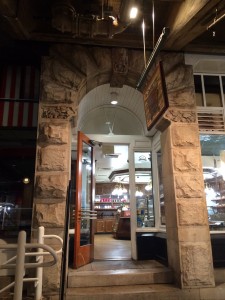
A few buildings have maintained their original fronts, like the Southern Candy Co. and the Atlanta Dollar, which used to be a hotel, giving the place a historic feel. There are also several examples of old metal work, which adorned many of the buildings of the era. This historic value of Underground Atlanta is unmatched by other areas of the city. The area reflects each of its many revivals and is a fantastic example of how the city has changed over time and has still managed to preserve parts of the past.
All of that being said, in my opinion, the Underground mall is best described as a little creepy. The place is so empty that it almost feels as if someone is following you at a distance. As I mentioned before, it is also relatively dark since it’s underground. This only added to the uneasiness I felt upon entering, and though it wasn’t serious enough to drive me away, it discouraged me from wanting to come back. At one point, a woman at a jewelry kiosk gestured with her finger for me to come over to her. Against my better judgment, perhaps, I did, and she asked, “Would you like me to make you some fine beaded jewelry?” Being the broke college student I am, I declined and walked away, a little amused and in all honesty, slightly shaken. This is an area that should be celebrated, a rare place where the past mingles with the present. Unfortunately, the present is giving way to the past, and it’s all being forgotten. And scaring people away in the process. In this case, however, the past provides a glimmer of hope. If the current trend continues, once Underground Atlanta dies, it will be revived once again. That’s all we can hope for.



